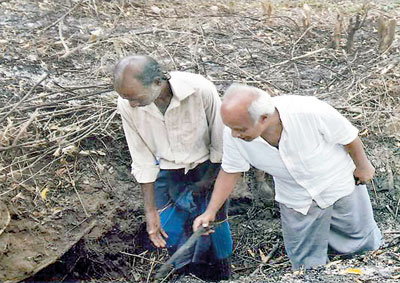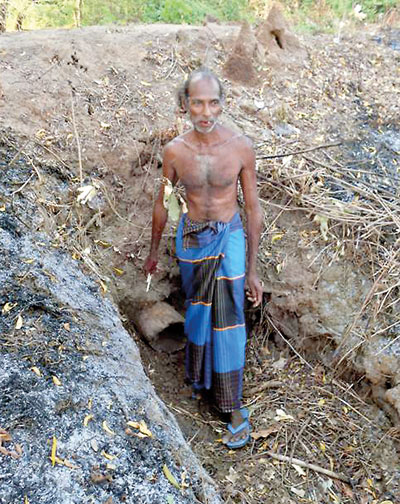Sunday Times 2
Avurudu ritual leads to discovery of ancient wooden sluice in Kohombankulama
View(s):An ancient wooden sluice has been discovered at Kohombankulama in Galgamuwa. Muthu Ayya, a farmer well known in Galigamuwa, discovered this rare wooden sluice, while he was clearing the thicket around the barely visible dam of the long forgotten Palugahawewa (tank).
The discovery was made following a visit by the Swarna Hansa Foundation to the Kohombankulama village. The foundation helps villagers to rehabilitate ancient wewas under its âDahasak Wewâ (or a thousand tank) programme.

Swarna Hansa Head Gallage Punyawardana and Muthu Aiya inspecting the site where the discovery of the wooden sluice was made
The Swarna Hansa team visited the Palugahawewa area at the invitation of Muthu Ayya who was engaged in Hena cultivation near the wewa. Discussions held with Muthu Ayya and a few village elders revealed the existence of an ancient wewa in the area which had been turned into a jungle infested with wild animals, including elephants.
After consultations with the villagers, a decision was taken to clear the jungle to locate the wewa and rehabilitate it to enable the villagers to carry out agricultural activities in an eco-friendly manner. Work began at the auspicious time of the Sinhala New year ritual — weda elleema.
It was while they were clearing the jungle that Muthu Ayya stumbled across the wooden sluice. Upon discovering it, he remembered that when he was six or seven years old, his great grandfather had told him that they had obtained water from this wewa for the paddy fields.
Swarna Hansa Foundation Head Gallage Punyawardana visited the site and was convinced it was an ancient sluice made of wood.
âIt is a rare marvel of the ancient Sinhala irrigational technology,â Mr. Punyawardana said, instilling a sense of pride in the minds of the villagers. âIt is still with you. Agriculture in this country is nothing but Sinhala culture. The Sinhala New Year is a sum total of symbolic events related to agriculture; the main livelihood of the Sinhalese. The New Yearâs weda ellema ritual is agriculture oriented,â he said, urging the villagers to start reconstructing the wewa.
The survival of this wooden structure for such a long time also shows that the ancient Sinhalese knew how best to use timber in irrigation technology, the Swarna Hansa head said.

Muthu Aiya points to the wooden sluice

